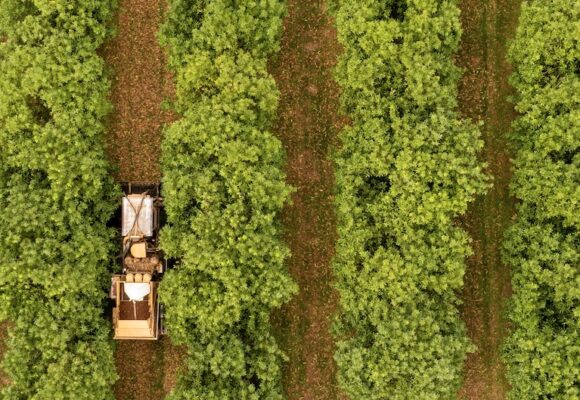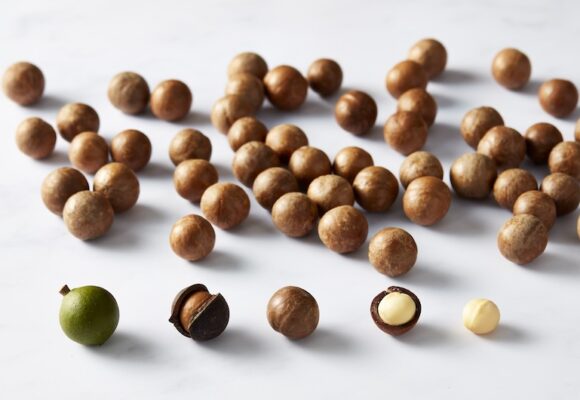Australia, the natural home of the macadamia tree, boasts a thriving industry rooted in its ancient rainforests. Originating in Australian soil some 60 million years ago, with our commercial industry now around 50 years old, macadamia orchards span more than 41,000 hectares across multiple regions, primarily in New South Wales and Queensland, with some small plantings in Western Australia too.

The majority of Australia’s orchards exist along a stretch of land on the east coast that spans some 2,200 kilometres from the Atherton Tablelands in the north to Port Macquarie in the south.
The two largest producing regions are the Northern Rivers in New South Wales and Bundaberg in Queensland. Collectively they account for 80% of Australia’s macadamia production, and while they’re both considered industry powerhouses, the two regions differ significantly in various respects. The following exploration delves into their distinct qualities and uncovers some interesting facts about Australia’s largest macadamia producing regions.
Fact #1: They have markedly different landscapes and climates
When it comes to topography, the Northern Rivers and Bundaberg have little in common. Much of the Northern Rivers consists of undulating terrain, while up in Bundaberg, there’s barely a hill in sight, with the region known for its vast expanses of flat land.

Situated about 550 kilometres apart, the two regions also experience very different weather patterns. Orchards in the Northern Rivers receive an average annual rainfall of between 1,800 and 2,300 millimetres, depending on where they are within the region, with the rain generally falling throughout the year. Winter sees lows of 3-4°C, while summer will usually deliver maximums of 28-30°C.
Further north in Bundaberg, average annual rainfall is substantially lower at around 1,000 millimetres, and this is typically delivered in late spring to early autumn (November to March), rather than distributed evenly year-round. Most of the time conditions are dry and often quite hot. Winter usually has some cold mornings with lows of 5-6°C; in summer, the mercury often peaks around 38°C. Bundaberg is said to have one of the world’s most agreeable climates, and is one of Australia’s food bowls, suited to growing a variety of food crops.

Fact #2: Macadamias originated in and around these two regions
Despite the differing conditions, macadamias thrive in both locations, owing to the fact that they originated not far from where they are now commercially produced.
Two species of macadamia, or hybrids of these species, are used for production of macadamia nuts in Australia – M. tetraphylla and M. integrifolia. The tetraphylla species originated in the area from south-east Queensland into the Northern Rivers, while integrifolia is native to the area from the NSW-Queensland border to Mt Bauple, about 1.5 hours south of Bundaberg.
Their natural adaptation to the climates of these two regions is why Australia has developed such a robust macadamia industry, with the trees proving to be perfectly suited to the climate in these areas.
Dozens of different macadamia varieties have been bred from these two species, and both regions are home to a wide range. Growers will select varieties that perform well in the soils and climate of their location. Some of the newer varieties being favoured in both regions are popular due to their ability to start bearing nuts at a younger age than their older counterparts. While traditionally macadamia trees would produce their first crop 5-7 years after planting, newer varieties are starting to bear in 3-5 years.
Fact #3: They have different on-farm practices
Not all Australian macadamias are grown the same, with growers in every region adapting their practices to suit the conditions and surrounds in which they operate.
While a few orchards in the Northern Rivers are irrigated, many are dryland farms that rely solely on rainfall. Because these orchards are not irrigated, they have less farm infrastructure and generally smaller machinery which suits the smaller farm holdings.
In Bundaberg, irrigation is essential, due to the hot, dry conditions that prevail most of the time. The macadamia orchards in this region are irrigated via dam water or bore water. Some growers have dams on their properties from which they can source their irrigation water, while others rely on the two government-operated dams and irrigation schemes in the region. The flatter country also lends itself to larger farms with longer rows of macadamia trees, with 400 metres being a typical row length. This makes it easier to manoeuvre machinery, with fewer turns required while harvesting.

The different climates in the two regions affect the timing of their crops. The warmer conditions in the north mean that flowering will typically start earlier in Bundaberg, usually in August while the Northern Rivers’ trees will start blooming in September. As a result, harvest in Bundaberg tends to start and finish a few weeks before the Northern Rivers.

Fact #4: the industry structure differs between regions
The Northern Rivers is where Australia’s commercial macadamia industry was first established and for many years it accounted for the majority of the Australian crop. This region is home to several hundred growers, often with smaller landholdings.

While it is a younger commercial growing region, Bundaberg’s macadamia industry has expanded significantly over the past decade, with substantial new plantings, many of which are now coming into bearing. The region has many generational farmers who have planted macadamia orchards and has also seen considerable corporate investment, accompanied by the development of much larger farms. Bundaberg now produces around 57% of Australia’s macadamia crop, and with significant areas of land that could yet be dedicated to macadamia farming, this is likely to rise.
Fact #5: Both regions have world-class processing facilities
The Northern Rivers and Bundaberg are both home to multiple large, world-class processing facilities where tens of thousands of tonnes of macadamia nuts from both regions are dried, cracked and packed every year, ready for global distribution.

The farms and processing facilities provide an important source of employment for many people living in and around these regions, and they are proud of the role they play in bringing Australia’s delicious native nut to consumers and products around the world.
If you’re looking for an Australian macadamia supplier, please visit the supplier directory, or contact Australian Macadamias Market Development Manager Jacqui Price.


